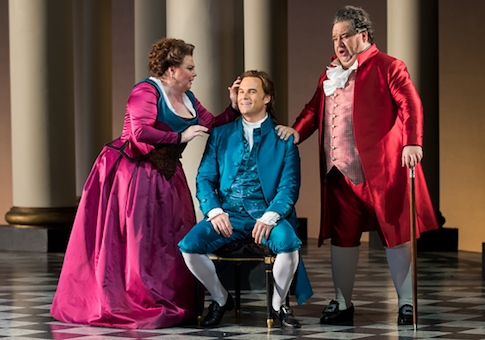Reviews of the Kennedy Center’s Marriage of Figaro have been middling, and I mostly concur with that assessment. Thankfully, when you are working with one of the most brilliant comedies conceived by man, even a middling production can be a treat.
The orchestra, led by director James Gaffigan, lacked oomph. Its overture was a tad on the soft side, while some of its arias—notably Cherubino’s stirring, love-drunk "Non So Più"–were charged through at such speed that mezzo-soprano Aleksandra Romano did not have an opportunity to showcase her talent beyond her ability to recite tongue-twisters.

The production’s standout was Amanda Majeski (Countess Almaviva), whose name gets it right: She was majestic. The soprano was the vision of wounded grace, with curly hair and a satin gown like a princess trapped in a castle. So statuesque and beautiful was Majeski that she almost undermined the premise of her character, who mourns the loss of her power over her wayward husband and later contrives to regain it. Why would the count be out in the village chasing skirts when he was married to someone so beautiful? The answer, I suppose, is that men can be awfully stupid.
Or rather, we all tend to be stupid. The Marriage of Figaro is about a tangled web of human relationships, and how unbridled passions make fools out of the passionate. Figaro loves the beautiful Susanna, who is lusted after by the count, who has forsaken his lawful wife the countess, who in turn is pined after—as though she stands in unapproachable light, and she very nearly does—by the boy Cherubino, who has a more age-appropriate lover in Barbarina. And so on. The illicit desires of these characters, combined with strict social conventions governing unchaperoned male-female interaction, get them into trouble very fast. As we have all experienced at one point or another in our lives, our secret sins tend to grow in size and intensity the more we strain to hide them from view. They are like pressure building in a contained space, building, building, until ultimately—kaboom.
The blow-ups in this opera are uproariously funny. All of them involve hiding of one sort or another. In the first act, an innocent Cherubino is forced to hide in Susanna’s chamber upon the approach of the not-so-innocent count, who is himself forced into hiding by the approach of another interloper. The uncovering of these characters, and their sheepish attempts to save face, will leave you in stitches.
Most of the hiding is in the literal, physical sense of the word, as further episodes in a dressing room closet and grove of pine trees demonstrate. However, the characters in this opera also hide behind social graces—an experience that should also be familiar to us all, even if the social graces of our time differ dramatically from those of late 18th-century Europe. So, for example, Susanna engages in a gradually escalating, hyper-courteous war of insults with her would-be rival, Marcellina, deferring to her superior age and experience, if you catch her drift. Today such an exchange would take place in the Instagram comments section, but the principle is the same: the smile masks the dagger.
Foremost, the Marriage of Figaro is about the intrigue and complications that accompany sex because of our own ebullient foolishness. It tells the story of young lovers, plotted rendezvous, vows made and broken, sexual quid pro quos, and private moments of crippling doubt, fear, jealousy, lust, and vengefulness. The men and women of the opera get one aria each (at least) to blow off steam about the opposite sex. A despairing Figaro denounces all women as "thorny roses" and "charming foxes," while the women band together to protect each other from the predations of the count. Thankfully, the opera is a comedy, so by the end of the day all wrongs have been righted—everyone gets married instead of offed, as they would have been in a tragedy.
Our culture is endlessly interested in sex, but rarely does it go deeper than the mechanics of the act. W.A. Mozart and librettist Lorenzo Da Ponte—no prudes I assure you—show that human relationships can be staged in a deeper way that is hilarious, brilliant, and humanity-affirming. On a stylistic level, they accomplish this feat through allusion and double entendre, not obscenity. More importantly, they pair the titillating aspects of sexuality with the profound and messy emotional aspects, and so present a more complete picture of human relationships. That is the brilliance of the Marriage of Figaro, and why even an ordinary performance cannot fail to delight.
